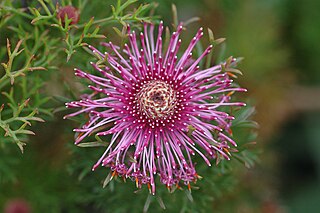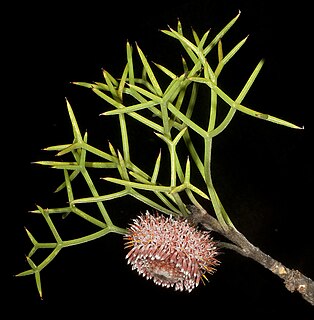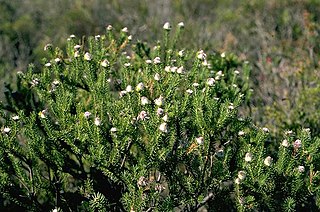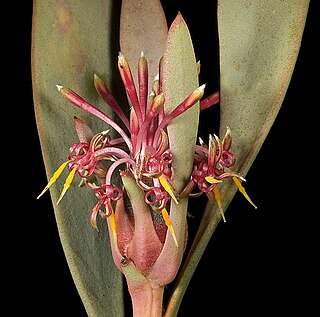
Isopogon formosus, commonly known as rose coneflower, is a species of flowering plant in the family Proteaceae and is endemic to the south-west of Western Australia. It is a shrub with divided leaves with cylindrical segments, and spherical to oval heads of pink or red flowers.

Isopogon cuneatus, commonly known as coneflower, is a species of plant in the family Proteaceae and is endemic to the south-west of Western Australia. It is a shrub with oblong to egg-shaped leaves with the narrower end towards the base, and flattened-spherical heads of glabrous pale to purplish pink flowers.

Isopogon dubius, commonly known as pincushion coneflower, is a species of plant in the family Proteaceae and is endemic to the south-west of Western Australia. It is a shrub with sharply-pointed, deeply lobed or pinnate leaves and more or less spherical heads of pink to reddish pink flowers.

Isopogon sphaerocephalus, commonly known as drumstick isopogon or Lesueur isopogon, is a species of plant in the family Proteaceae and is endemic to the south-west of Western Australia. It is a shrub with linear to narrow egg-shaped leaves and spherical heads of hairy white to creamy yellow flowers.

Isopogon adenanthoides, commonly known as the spider coneflower, is a plant in the family Proteaceae and is endemic to the southwest of Western Australia. It is an erect shrub with sharply-pointed, trifid leaves and spherical heads of pink flowers.

Isopogon asper is a species of plant in the family Proteaceae and is endemic to the south-west of Western Australia. It is a low shrub with crowded pinnate leaves and flattened spherical heads of glabrous pink flowers.

Isopogon alcicornis, commonly known as the elkhorn coneflower, is a plant in the family Proteaceae and is endemic to part of the south coast of Western Australia. It is a low shrub with pinnately-lobed leaves and oval heads of hairy, white or pink flowers.

Isopogon axillaris is a species of plant in the family Proteaceae and is endemic to the south-west of Western Australia. It is a shrub with thick, linear to lance-shaped leaves with the narrower end towards the base and oval heads of pink or purple flowers.

Isopogon baxteri, commonly known as the Stirling Range coneflower, is a species of plant in the family Proteaceae and is endemic to the south-west of Western Australia. It is an erect shrub with wedge-shaped, often 3-lobed, toothed leaves and flattened spherical heads of hairy pink flowers.

Isopogon divergens, commonly known as spreading coneflower, is a species of plant in the family Proteaceae and is endemic to the south-west of Western Australia. It is a shrub with pinnate leaves and more or less spherical heads of glabrous pink flowers followed by an oval to cylindrical fruiting cone.

Isopogon teretifolius, commonly known as nodding coneflower, is a species of flowering plant in the family Proteaceae and is endemic to the southwest of Western Australia. It is an erect shrub with cylindrical, sometimes branched leaves, and flattened-spherical heads of hairy pinkish flowers.

Petrophile cyathiforma is a species of flowering plant in the family Proteaceae and is endemic to southwestern Western Australia. It is a small shrub with needle-shaped, sharply-pointed leaves and cup-shaped heads of glabrous, bright yellow flowers.

Petrophile plumosa is a species of flowering plant in the family Proteaceae and is endemic to southwestern Western Australia. It is a shrub with rigid, sharply-pointed, sometimes lobed leaves, and more or less spherical heads of hairy, pale yellow flowers.

Petrophile scabriuscula is a species of flowering plant in the family Proteaceae and is endemic to southwestern Western Australia. It is a dense, prickly shrub with sharply-pointed, needle-shaped leaves more or less pressed against the branchlets, and oval heads of hairy, yellow to creamy-yellow flowers.
Petrophile stricta is a species of flowering plant in the family Proteaceae and is endemic to the south-west of Western Australia. It is an erect, spreading shrub with needle-shaped, sharply-pointed leaves, and oval heads of hairy, pink to cream-coloured flowers.

Isopogon crithmifolius is a species of plant in the family Proteaceae and is endemic to the south-west of Western Australia. It is a shrub with divided leaves and more or less spherical heads of glabrous reddish pink flowers.

Isopogon pruinosus is a species of flowering plant in the family Proteaceae and is endemic to southwestern Western Australia. It is a compact, spreading shrub with narrow egg-shaped leaves with the narrower end towards the base and spherical to elliptic heads of pink flowers.

Isopogon scabriusculus is a species of flowering plant in the family Proteaceae and is endemic to southwestern Western Australia. It is a shrub with cylindrical, or narrow flat, sometimes forked leaves, and spherical to oval heads of pink or red flowers.

Isopogon tridens, commonly known as the three-toothed coneflower, is a species of flowering plant in the family Proteaceae and is endemic to the southwest of Western Australia. It is a shrub with wedge-shaped leaves with two or three sharply-pointed teeth, and flattened-spherical heads of glabrous creamy white, sometimes purple flowers.
Isopogon villosus is a species of flowering plant in the family Proteaceae and is endemic to southwestern Western Australia. It is a tufted shrub with cylindrical leaves with twenty-five to thirty-two widely diverging lobes, and oval heads of cream-coloured to yellow flowers.


















